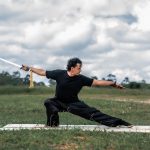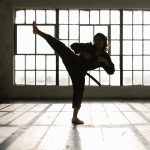The 2024 Paris Olympics will showcase a dazzling array of martial arts, captivating audiences with their skill, technique, and physical prowess.
This highly anticipated event will feature five disciplines: boxing, fencing, judo, taekwondo, and wrestling. With their ancient origins and rich histories, these martial arts embody the spirit of sportsmanship, discipline, and respect.
Each discipline brings its own set of rules, strategies, and weight classes, ensuring a fair and competitive environment for the participants.
Join us as we explore the world of martial arts in the Olympics and celebrate the extraordinary athletes who will showcase their skills on the grandest sporting stage of all.
Key Takeaways
- The 2024 Paris Olympics will feature 5 martial arts: boxing, fencing, judo, taekwondo, and wrestling. Karate will not be included.
- Fencing first appeared at the 1612 Cotswold Olympick Games and was introduced at the 1896 Athens Olympics. There are three types of fencing: foil, épée, and sabre.
- Judo was introduced as an Olympic martial art in 1964 at the Tokyo Olympics, while Taekwondo was introduced in 1988 at the Seoul Olympics. Both martial arts are featured in the 2024 Paris Olympics.
- Wrestling was the first Olympic martial art, introduced in Ancient Greece at the 18th Olympiad, 708 BCE. Greco-Roman wrestling was introduced in 1896 at the first modern Olympic Games, and freestyle wrestling was introduced in 1904. Women's wrestling was introduced in 2004 at the Athens Olympics.
2024 Paris Olympics Martial Arts Lineup
The 2024 Paris Olympics will feature a lineup of four martial arts: boxing, fencing, judo, and taekwondo. Each of these martial arts brings its own unique history, techniques, and cultural impact to the Olympic stage.
Fencing, with its historical significance and evolution of techniques, has been a staple in the Olympics since the 1896 Athens Games. It originated in the 17th century and has evolved over time to become a highly strategic and precise sport. Fencers don full body protection and use three different weapons: foil, épée, and sabre. The sport requires quick reflexes, agility, and mental acuity.
Judo, with its cultural impact and worldwide popularity, was introduced as an Olympic martial art in 1964 at the Tokyo Olympics. Developed in Japan in the late 19th century, judo emphasizes techniques that allow a smaller combatant to overcome a larger opponent through leverage and skill. Judo has gained a massive following worldwide and continues to be practiced by millions of people.
These martial arts, along with boxing and taekwondo, will showcase the athleticism, skill, and discipline of the athletes competing in the 2024 Paris Olympics. Each martial art brings its own rich history and techniques, captivating audiences and inspiring future generations of practitioners. The inclusion of fencing and judo in particular highlights the diverse range of martial arts and their worldwide impact.
Wrestling: Ancient Origins and Olympic History
Wrestling, with its ancient origins and rich Olympic history, holds a prominent place among the martial arts featured in the Olympics. Dating back to the 18th Olympiad in 708 BCE, wrestling was one of the first Olympic martial arts. It has since evolved, with the introduction of Greco-Roman wrestling in 1896 and freestyle wrestling in 1904. Women's wrestling made its Olympic debut in 2004. Wrestling has been a competitive sport in every modern Olympic Games, showcasing the strength, skill, and determination of its athletes.
The table below highlights the significance of wrestling in the Olympics, as well as the evolution of boxing as an Olympic sport and its impact on athletes:
| Wrestling | Boxing |
|---|---|
| Ancient origins | Introduced in 688 BCE in Ancient Greece |
| First Olympic martial art | Reintroduced in 1904 at the St Louis Olympics |
| Greco-Roman wrestling introduced in 1896 | Women's boxing introduced in 2012 |
| Freestyle wrestling introduced in 1904 | Three 3-minute rounds with 1-minute breaks |
| Women's wrestling introduced in 2004 | Weight classes for men and women |
Wrestling's historical significance and continued presence in the Olympics make it a sport of great importance. The evolution of boxing as an Olympic sport has also contributed to the excitement and competitiveness of the Games, providing athletes with a platform to showcase their skills and determination. As we look forward to the 2024 Paris Olympics, wrestling and boxing will undoubtedly captivate audiences and inspire future generations of martial artists.
Boxing: A Timeless Olympic Martial Art
Boxing, a perennial Olympic martial art, continues to captivate audiences with its timeless appeal and fiercely competitive nature. With origins dating back to Ancient Greece, boxing has been an integral part of the Olympic Games since its reintroduction in 1904.
The significance of boxing in the Olympics lies in its ability to showcase the exceptional skill, speed, and strength of its athletes. Olympic boxing follows a set of rules that emphasize fair play and sportsmanship. Matches consist of three three-minute rounds with a one-minute rest between rounds. Men and women compete in different weight classes, ensuring that boxers of similar size and strength face off against each other.
The weight classes for men include flyweight, lightweight, middleweight, and more, while women's weight classes include featherweight, lightweight, and middleweight, among others. Boxing's long-standing presence in the Olympics is a testament to its enduring popularity and status as a revered martial art.
Fencing: The Elegant Sport of Swordplay
Fencing showcases the elegant art of swordplay in the Olympic Games, captivating audiences with its grace, precision, and strategic maneuvers. Here are five reasons why fencing is a sport that demands mastery:
- Fencing techniques: Fencers employ a variety of techniques, including attacks, counterattacks, and parries, to outwit their opponents. Each movement requires precise footwork and coordination, making it a challenging sport to master.
- Strategic thinking: Fencing is not just about physical agility; it also requires strategic thinking. Fencers must anticipate their opponent's moves and adapt their tactics accordingly, making split-second decisions that can determine the outcome of a match.
- Mental discipline: Fencing requires intense focus and concentration. Fencers must stay calm under pressure, analyzing their opponent's actions and responding with calculated precision.
- Physical conditioning: Fencing demands exceptional physical conditioning. Fencers must possess strength, agility, and endurance to perform quick and explosive movements while maintaining proper form.
- Judo training methods: Fencers can benefit from incorporating Judo training methods into their practice. Judo emphasizes balance, flexibility, and body control, which are essential attributes for fencers to develop.
Judo: The Gentle Way in Olympic Competition
Judo, known as the gentle way, showcases the art of grappling and submission techniques in Olympic competition. Originating in Japan, judo has become a highly respected martial art that emphasizes technique, leverage, and control rather than brute strength.
Judo training techniques focus on developing balance, flexibility, and mental discipline, making it not only a physically demanding sport but also a path to personal growth.
In Olympic competition, judokas aim to score an Ippon, which can be achieved through powerful throws, pinning an opponent on their back, or submission via arm lock or choke. Judokas have a range of 68 throws and 32 grappling techniques at their disposal, requiring a deep understanding of timing, positioning, and strategy.
Mastery of these techniques and strategic awareness are key to success in Olympic judo competition.
Taekwondo: The Dynamic Korean Martial Art
Taekwondo, originating in Korea and becoming an Olympic martial art in 2000, is a dynamic and highly skilled martial art that showcases powerful kicks, precise strikes, and strategic footwork. It has a rich history and cultural significance, deeply rooted in Korean tradition. Taekwondo training focuses on developing not only physical strength but also mental discipline and self-control.
Here are some key aspects of taekwondo:
- Forms (Poomsae): These are a series of choreographed movements that require precision and grace, allowing practitioners to develop their technique and control.
- Sparring (Kyorugi): Taekwondo practitioners engage in controlled combat, combining their kicks and strikes to score points against their opponents.
- Breaking (Gyukpa): Demonstrating strength and technique, practitioners break boards or other materials using powerful strikes.
- Self-defense techniques: Taekwondo teaches a variety of techniques to defend oneself in real-life situations, promoting confidence and personal safety.
- Olympic competition: Taekwondo athletes compete in weight categories, showcasing their agility, speed, and accuracy in a quest for gold.
Taekwondo is a martial art that embodies discipline, respect, and perseverance, making it a highly respected and globally recognized sport. Its training and techniques provide a pathway to personal growth and achievement.
Fencing: Attire and Rules at the Olympics
Continuing the exploration of Olympic martial arts, the attire and rules of fencing at the Olympics showcase the precision and strategy required in this centuries-old sport. Fencers dress in full body protection, including masks, gloves, jackets, and underarm protection. The outfit is made with bulletproof material Kevlar for maximum safety. Fencers also wear lamé jackets that keep score by distinguishing between on and off hits. The Olympics feature individual and team fencing events. In individual fencing, the winner is the first to accumulate 15 points through three three-minute periods with one-minute breaks in between. The rules of fencing emphasize quick reflexes, technical skill, and mental agility, making it a captivating event to watch and a thrilling discipline to master.
| Equipment and Safety Measures |
|---|
| Full body protection, including masks, gloves, jackets, and underarm protection |
| Bulletproof material Kevlar for maximum safety |
| Lamé jackets for scoring between on and off hits |
The table above highlights the essential equipment and safety measures in fencing, ensuring the utmost protection for the athletes.
Judo: Winning Techniques and Scoring in Olympic Judo
Winning techniques and scoring in Olympic Judo showcase the skill and precision required in this martial art. Judo, with its rich history and cultural significance in Japan, offers a range of different techniques and throws that judokas can utilize to secure victory.
Here are five key aspects of winning in Olympic Judo:
- Ippon: To win in Judo, a Judoka must score an Ippon, which can be achieved by throwing an opponent onto their back with force, pinning them on their back for 20 seconds, or submitting them via an arm lock or choke.
- Throws: Judo encompasses a total of 68 throws, each requiring precise timing, balance, and technique.
- Grappling Techniques: In addition to throws, judokas can employ 32 grappling techniques to gain control over their opponents on the ground.
- Combination Attacks: Success in Judo often relies on the ability to seamlessly transition between different techniques, setting up opponents for effective throws or submissions.
- Tactical Awareness: Judo matches require strategic thinking, as judokas must anticipate their opponent's moves and exploit weaknesses while maintaining their own defensive posture.
Mastering these techniques and understanding the scoring system in Olympic Judo is crucial for aspiring judokas to excel in this dynamic and respected martial art.
Taekwondo: Olympic Rules and Weight Classes
As we delve into the realm of Taekwondo in the Olympics, it is important to familiarize ourselves with the rules and weight classes that govern this dynamic martial art.
Taekwondo, which originated in Korea, became an official Olympic sport in 2000 at the Sydney Olympics. In the Olympic taekwondo competition, there are different weight classes for both men and women. The men's weight classes include 58 kg, 68 kg, 80 kg, and 80 kg+, while the women's weight classes include 49 kg, 57 kg, 67 kg, and 67 kg+.
These weight classes ensure fair competition by grouping fighters of similar size and strength. In terms of scoring, taekwondo fighters can win by knockout, outscoring their opponent, reaching a 20-point gap, or being the first to reach 40 points. Points are scored by hitting an opponent's head or trunk protector with force.
The Olympic taekwondo scoring system emphasizes precision, technique, and control. With these rules and weight classes in place, the Olympic taekwondo competition showcases the skill, athleticism, and artistry of this captivating martial art.
Frequently Asked Questions
How Are the Martial Arts Selected for Inclusion in the Olympics?
The selection process for Olympic martial arts involves considering various criteria for inclusion. These criteria may include the sport's global popularity, its adherence to Olympic values and principles, and its ability to provide a thrilling and competitive spectacle for athletes and spectators alike.
Are There Any Age Restrictions for Athletes Competing in Olympic Martial Arts?
Age restrictions for athletes competing in Olympic martial arts vary depending on the sport. While there is no specific age limit, athletes must meet the minimum age requirement set by each sport's governing body. The impact of age on performance in Olympic martial arts is a complex factor influenced by factors such as skill level, physical conditioning, and experience.
Can Athletes Compete in Multiple Martial Arts at the Same Olympics?
Athletes in the Olympics can specialize in multiple martial arts, allowing them to compete in different disciplines. However, they must choose one discipline to represent in each individual event, showcasing their expertise in that specific martial art.
How Are the Winners Determined in Team Fencing Events?
In team fencing events, winners are determined through a combination of individual and team performances. Strategies, such as target selection and coordination, play a crucial role. The history of team fencing showcases the evolution of tactics and techniques used in these thrilling competitions.
Are There Any Specific Rules or Restrictions Regarding the Equipment Used in Olympic Judo and Taekwondo Competitions?
In Olympic judo and taekwondo competitions, there are specific rules and restrictions regarding the equipment used. Safety is of utmost importance, with regulations on protective gear and uniform standards to ensure fair and secure competitions.
Conclusion
In conclusion, the martial arts featured in the 2024 Paris Olympics showcase the incredible skill and athleticism of the participating athletes. These disciplines include wrestling, boxing, fencing, judo, and taekwondo.
With their rich histories and unique styles, these martial arts captivate audiences with their intensity and technique. From the ancient origins of wrestling and boxing to the elegance of fencing and the dynamic nature of taekwondo, each discipline offers its own distinct appeal.
These martial arts embody the spirit of sportsmanship and discipline on the grandest sporting stage. Athletes who participate in these disciplines train for years to master their craft and compete at the highest level.
Witness the extraordinary talents of these athletes as they compete for glory and inspire awe in spectators worldwide. The 2024 Paris Olympics will undoubtedly be a showcase of the remarkable abilities displayed in these martial arts.
- 15 Best Martial Arts Weapons (Fighting & Training) - October 14, 2024
- Is Fencing a Martial Art? (Yes, 4 Reasons Why) - October 14, 2024
- 7 Best Martial Arts for Self-defense Ranked (Highly Effective) - October 14, 2024










